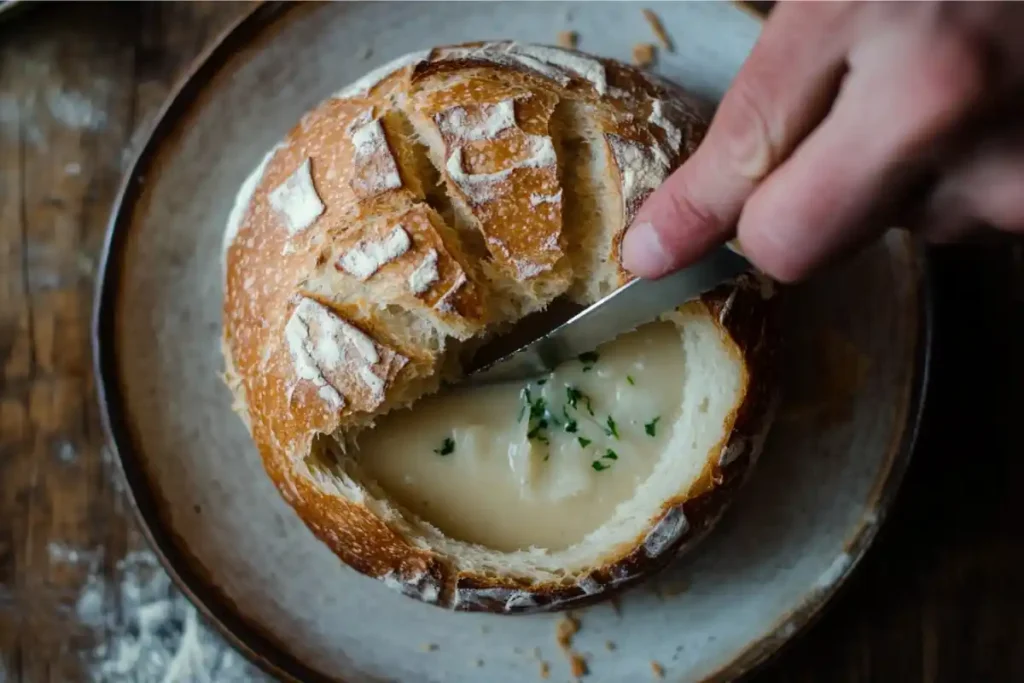Introduction to Sourdough Bread Bowls
What Is a Sourdough Bread Bowl and How Do You Eat It?
A sourdough bread bowl isn’t just a food container—it’s a fun and tasty way to eat. In particular, these bowls are made by scooping out round loaves of sourdough bread. The hollowed center holds soups, dips, or stews. The tangy, chewy bread works well with all kinds of fillings. As a result, it makes a great option for meals.
Sourdough bread bowls are a fun and delicious way to enjoy your favorite soups or dips. But really, how do you eat sourdough bread bowl in the best way?
Sourdough bread is popular for its special taste, created through a natural process. Additionally, using it as a bowl gives your meal a homemade and cozy feel. It doesn’t just hold your food but also adds an eco-friendly touch since you can eat it.
Why Sourdough Is Perfect for Bread Bowls
Why use sourdough for bread bowls? First, its firmness and strength are key. Softer breads soak up liquids too quickly and fall apart. On the other hand, sourdough’s strong crust keeps the bowl solid and holds fillings nicely. Its tangy taste makes soups or dips even better, thus creating a tasty balance.
Sourdough is also healthier than most breads. Thanks to this, it’s easier to digest and doesn’t cause sugar spikes. Moreover, it’s packed with nutrients like vitamins and minerals. These perks make it a smart way to enjoy meals. Finally, because the bowl is edible, you won’t waste food.
In summary, with its mix of usefulness and great taste, the sourdough bread bowl is a winner.
Choosing the Right Sourdough Bread Bowl
How to Select the Best Sourdough Bread Bowl for Your Meal
Choosing the right sourdough bread bowl makes a big difference in your experience. First, look for loaves with a thick, sturdy crust. This prevents the bowl from becoming soggy when filled with soup or stew. Additionally, the interior should be soft and chewy to complement your fillings.
When selecting a loaf, size matters. For instance, a smaller loaf works well for dips or individual servings. On the other hand, larger loaves are better for sharing or heartier meals. If you’re making your own sourdough, consider shaping it specifically for your intended purpose.
What to Look for in Texture and Size
The texture of the sourdough bread is equally important. Ideally, the crust should have a slight crunch while the interior remains moist and springy. The right balance ensures the bread bowl holds its shape and is enjoyable to eat.
Moreover, if you’re using the bread bowl for soups, opt for loaves with a tight crumb structure. This helps prevent leaks while enhancing the overall eating experience. In addition, loaves with a well-developed sourdough flavor add a tangy note that pairs beautifully with creamy or savory fillings.
For tips on creating the perfect sourdough texture, check out this guide on making sourdough garlic bread.
Preparing the Bread Bowl for Eating
How to Hollow Out a Bread Bowl Without Breaking It

Hollowing out a sourdough bread bowl requires care. To begin, use a serrated knife to cut a circular lid from the top of the loaf. Next, gently pull out the interior bread, leaving a 1-inch wall around the edges. This step ensures the bowl remains sturdy enough to hold your filling.
Additionally, be sure to save the bread pieces you remove—they’re great for dipping! If you’re new to this technique, practice on a spare loaf to perfect your method.
Tips for Preserving the Edibility of the Bowl
The key to enjoying a sourdough bread bowl is maintaining its freshness. First, avoid hollowing out the bowl too far in advance. Instead, prepare it just before serving to keep it from drying out. Furthermore, if your soup is especially hot, allow it to cool slightly before pouring it in.
To enhance the bowl’s flavor and durability, consider brushing the inside with melted butter or olive oil. Afterward, toast it lightly in the oven. This creates a protective layer that prevents the liquid from soaking through. Finally, serve your sourdough bread bowl on a plate to catch any spills and keep the presentation tidy.
By preparing the bread bowl thoughtfully, you’ll enjoy a delicious, mess-free meal. For more creative ways to use sourdough, check out this sourdough bread bowl guide.
When preparing a sourdough bread bowl, you may wonder, how do you eat sourdough bread bowl without making a mess?
Filling Your Bread Bowl: Delicious Options
Classic Soup Choices for Bread Bowls

One of the most popular ways to enjoy a sourdough bread bowl is with classic soups. For instance, creamy options like broccoli cheddar or clam chowder work beautifully. These soups not only taste amazing but also pair well with the tangy flavor of the bread.
Additionally, hearty soups such as beef stew or chili are excellent choices. Their thick consistency ensures the liquid doesn’t leak through the bread too quickly. If you’re looking for inspiration, tomato bisque is another great option. Its rich, tangy flavor complements the sourdough perfectly.
To explore more soup recipes, consider Panera’s Turkey Chili guide, which offers tips for creating a hearty, satisfying dish.
Innovative Fillings: From Chowders to Chili
If you want to get creative, try non-traditional fillings for your bread bowl. Chowders, such as corn or seafood chowder, add a luxurious twist. Meanwhile, vegetarian options like roasted vegetable stews or lentil soup cater to a variety of dietary preferences.
For dips, consider filling the bread bowl with spinach and artichoke dip or a creamy queso. In addition, dessert lovers can experiment by filling the bowl with sweet options like chocolate fondue or bread pudding.
No matter the filling, the key is balancing flavors to match the bread’s tangy undertones. Finally, remember to enjoy the edible bowl itself after savoring the contents.
Eating Techniques for Sourdough Bread Bowls
How Do You Eat a Sourdough Bread Bowl?
Eating a sourdough bread bowl can be as fun as it is delicious. To start, scoop out the filling with a spoon, enjoying the flavors and textures. Then, as the liquid level lowers, tear off small pieces of the bread bowl. Dip them into the remaining soup or stew for maximum flavor.
Moreover, don’t forget the lid! The circular piece of bread you removed makes an excellent dipper. As you finish, you’ll find yourself eating the bowl itself, savoring every last bite.
Managing Liquids and Keeping It Clean
One of the biggest challenges is avoiding spills. To make this easier, serve the bread bowl on a wide plate or in a shallow bowl. This catches any overflow and keeps the table tidy.
Additionally, avoid cutting into the bread bowl too early. Instead, wait until you’ve finished most of the filling. This keeps the structure intact and prevents leaks. Finally, pace yourself—eating too fast might lead to a messy meal!
For more fun ideas on serving bread, check out this guide on shaping sourdough bread bowls. Whether you’re enjoying soup, stew, or dip, mastering the art of eating a sourdough bread bowl makes the experience even better.
Why Sourdough Bread Bowls Are So Popular
The History and Charm of Sourdough
Sourdough has a long history that makes it special. For centuries, it has been valued for its unique flavor and natural fermentation process. It’s not just bread; it’s a tradition. Moreover, sourdough bread bowls bring a rustic, artisanal charm to meals. They are simple yet elegant, turning ordinary soups into something extraordinary.
Additionally, sourdough bread bowls are practical and eco-friendly. Since they’re edible, there’s no waste—every part of the bowl is enjoyed. As a result, they’re both a treat for your taste buds and a sustainable choice.
Health Benefits and Nutritional Value
Sourdough bread is not only delicious but also healthier than many other breads. Thanks to its natural fermentation, it’s easier to digest. This process also breaks down gluten, which can make it easier for some people to tolerate. Furthermore, sourdough has a lower glycemic index, meaning it won’t cause blood sugar spikes.
It’s also rich in nutrients like B vitamins, iron, and magnesium. For these reasons, using sourdough as a bread bowl is both tasty and nutritious. In short, sourdough bread bowls are a win-win, offering flavor and health benefits in one delightful package.
Tips for Making Sourdough Bread Bowls at Home
Basic Recipe for Homemade Sourdough Bowls
Making sourdough bread bowls at home is easier than you might think. First, you’ll need a reliable sourdough starter. Combine it with flour, water, and salt to make a basic dough. Then, let it ferment overnight to develop flavor.
Shape the dough into round loaves and let them rise. Before baking, score the tops with a sharp knife to allow steam to escape. Bake in a preheated oven with steam to achieve a crusty exterior. Once baked and cooled, hollow out the center, and your bread bowl is ready to use.
Common Mistakes and How to Avoid Them
Homemade sourdough bread bowls are rewarding, but mistakes can happen. To start, avoid using dough that’s too wet, as it can collapse during baking. In addition, don’t rush the fermentation process. This step is crucial for the bread’s flavor and texture.
Moreover, make sure your oven is hot enough. A lower temperature can lead to a dense loaf instead of a light, airy bread. Finally, always allow the bread to cool before cutting. This prevents the interior from becoming gummy.
If you’re new to sourdough baking, start with small loaves to practice shaping and baking techniques. With time and patience, you’ll master the art of making perfect bread bowls.
FAQs About Sourdough Bread Bowls
Can You Eat the Entire Bread Bowl?
Yes, you can eat the whole bread bowl, and that’s what makes it so fun! First, enjoy the filling, whether it’s soup, stew, or dip. Then, start tearing pieces from the sides of the bread bowl and dipping them into the remaining contents. However, if the filling is too hot, let it cool slightly before eating the bread to avoid burning your mouth.
How Long Do Sourdough Bowls Stay Fresh?
Sourdough bread bowls are best eaten fresh, usually within a day of baking. If you need to store them, keep the bread in a paper bag or loosely covered to maintain the crust. However, avoid storing them in plastic, as it can make the crust soft. For extended storage, you can freeze the bread bowl and reheat it before use.
What Are Some Popular Fillings?
Classic soups like clam chowder, tomato bisque, and broccoli cheddar are favorites for sourdough bread bowls. In addition, hearty options like chili or beef stew work well. If you prefer dips, spinach-artichoke or queso are great choices. Finally, don’t hesitate to try dessert fillings like chocolate fondue for something sweet and unique.
Conclusion and Final Thoughts
Sourdough bread bowls are more than just a meal—they’re an experience. They combine the hearty flavor of sourdough with the fun of edible servingware. So, how do you eat sourdough bread bowl? Start by savoring the filling, then enjoy the tangy, chewy bread itself.
These versatile bowls work for soups, stews, dips, and even desserts. Whether you buy them or bake them at home, they’re sure to impress. Moreover, sourdough bread bowls are eco-friendly, reducing waste while adding a rustic charm to your table.
Finally, don’t forget to experiment with different fillings to keep things exciting. Whether you’re hosting a dinner or enjoying a quiet meal, sourdough bread bowls are a delicious choice. For more tips and recipes, check out other articles on sourdough and bread-making for inspiration.

